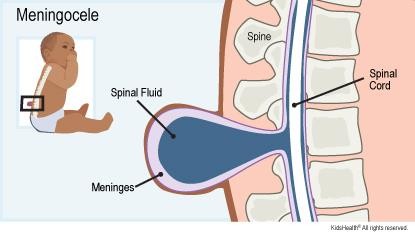A nurse is caring for a newborn who was born 6 hr ago.
Complete the diagram by dragging from the choices below to specify what condition the newborn is most likely experiencing, 2 actions the nurse should take to address that condition, and 2 parameters the nurse should monitor to assess the newborn's progress.
The Correct Answer is []
Potential condition
Correct Answer: B. Meningocele
Rationale: Based on the provided physical examination details, the newborn is most likely experiencing a meningocele, which is indicated by the presence of a sac in the lumbar area. This condition is a type of neural tube defect where a sac of fluid comes through an opening in the baby's back. However, the absence of other neurological symptoms and the intact reflexes suggest that the condition has not severely affected the newborn's neurological functions.

Actions to Take (2)
Correct Answers: C, E
The two actions the nurse should take to address this condition include: applying a non-adhering sterile saline moist compress to the sac to prevent it from drying and to protect it from trauma, and educating the guardians about the condition, its implications, and the potential need for surgical intervention to repair the defect.
Parameters to monitor
Correct Answer: A, C
Rationale: The two parameters the nurse should monitor to assess the newborn's progress are the head circumference and serial head ultrasounds. Monitoring head circumference is crucial as an increase may indicate hydrocephalus, which can be associated with meningocele. Serial head ultrasounds are necessary to assess for any changes in the brain structure or development of hydrocephalus. These measures will help ensure that any complications are identified and managed promptly.
Nursing Test Bank
Naxlex Comprehensive Predictor Exams
Related Questions
Correct Answer is C
Explanation
Rationale:
A. "My child will take the enzymes 2 hours before meals.": Pancreatic enzymes should be taken with meals or snacks, not before.
B. "My child will take the enzymes to improve her metabolism.": While pancreatic enzymes help with digestion, their purpose is not to improve metabolism.
C. "My child will take the enzymes to help digest the fat in foods.": This statement accurately reflects the purpose of pancreatic enzymes in cystic fibrosis. These enzymes are necessary because individuals with cystic fibrosis often have pancreatic insufficiency, leading to difficulty digesting fats and certain nutrients in food.
D. "My child will take the enzymes following meals.": Pancreatic enzymes should be taken with meals or snacks, not after.
Correct Answer is B
Explanation
Rationale:
A. Smiles when a parent appears: This is a social and emotional developmental milestone typically achieved by an 8-month-old infant and is not indicative of cerebral palsy.
B. Sits with pillow props: Difficulty sitting without support or requiring props to maintain a sitting position can be a manifestation of cerebral palsy, reflecting motor delays and impaired muscle control.
C. Tracks an object with eyes: Tracking objects with eyes is a visual developmental milestone and does not directly relate to cerebral palsy.
D. Uses a pincer grasp to pick up a toy: The pincer grasp typically develops around 9 to 12 months of age and is not directly related to cerebral palsy.
Whether you are a student looking to ace your exams or a practicing nurse seeking to enhance your expertise , our nursing education contents will empower you with the confidence and competence to make a difference in the lives of patients and become a respected leader in the healthcare field.
Visit Naxlex, invest in your future and unlock endless possibilities with our unparalleled nursing education contents today
Report Wrong Answer on the Current Question
Do you disagree with the answer? If yes, what is your expected answer? Explain.
Kindly be descriptive with the issue you are facing.
